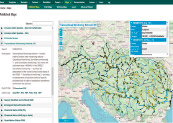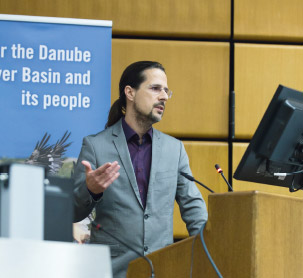Danube Watch 1/2020 - Data, the ICPDR and DanubeGIS
Data, the ICPDR and DanubeGIS
Data is essential to all of the endeavours of the ICPDR. Without the data collected in the field, decision-makers would be unable to do their very namesake. In order to better make use of the large amount of data produced within the Danube River Basin, the ICPDR has its own web-based Geographic Information System (GIS), which it uses to collect, sort and work with data submitted by researchers and experts from respective ICPDR-affiliated countries.
What is the purpose of DanubeGIS? Its role is vital for the work of the ICPDR. As a platform with many tools, it supports contracting parties in collection, analysis and visualisation of data necessary to meet the demands of the Water Framework Directive and the Flood Directive reporting at the Danube River Basin-Wide scale. This larger scale encompasses rivers with catchment areas greater than 4,000 km², lakes with surface areas greater than 100 km² and important transboundary groundwater bodies larger than 4,000 km².
DanubeGIS also helps to support the work of ICPDR Expert Groups such as those dealing with accident risk sites or the data feeding into the Transitional Monitoring Network (TNMN). Furthermore, sub-basin Furthermore, activities like those specifically focused on the Tisza sub-basin and others, can utilise the system to their benefit.
The data itself is provided and owned by the Danube River Basin countries and stored on the DanubeGIS platform as datasets within a file repository. From this, the geo-database is fed with separate schemas for final approved data reports and for the most up-to-date basin-wide data. Tools with which users can work with the data are also present, and consist of validation, analysis and retrieval tools. These make many things possible. Expert users can accomplish multi-level data quality checking as well as store queries in order to produce tables, graphs and views as a basis for layers. These layers are the basis for production of ICPDR thematic maps and are then published using open source software, and made accessible via OGC-compliant web services.
While the system offers a plethora of tools and possibilities for working with the available datasets, it has its limitations and restrictions. For example, DanubeGIS cannot replace cartographic software packages, as it cannot automatically produce high-quality paper maps. It also is not meant for tasks such as extensive spatial analysis that would be achieved by using the functionalities of a desktop GIS. Finally, it is not intended to act as a replacement for any of the existing ICPDR countries’ national GIS platforms.

Data classifications are defined by each of the countries that submitted it. The different classification levels are as follows:
- 1. Unclassified
Available for for all users (free use). - 2. Restricted
Not for general disclosure/ for self-registered (and all higher-level) users. - 3. Confidential
Available for someone who can be trusted with information/ available for entrusted (and all higher-level) users upon request. - 4. Secret
Kept or meant to be kept private, unknown or hidden from all but a select group of people for available only for nominated (internal) expert users for ICPDR-related work.
The concept of DanubeGIS began in 2003 when a needs assessment was completed followed by a conceptual design of the system. Between 2004 and 2006, a strategic plan was developed along with a system definition by the Environmental Agency of Austria, and a prototype was financed by the UNDP/GEF Danube Regional Project and the EU. Version I of the system, developed by the Environmental Agency of Austria, and based on the ESRI ArcIMS server, was launched in 2007. 2009 and 2010 saw the first major basin-wide collection of data for the DRBMP and the first sub-basin data collection for the Tisza RBMP, respectively. Operations were then moved over to Version II (developed by the ICPDR Secretariat based on open source software GeoServer, PostGIS and Drupal) in 2012. The system is continuously improved based on guidance by the IMGIS EG of the ICPDR.
For the benefit of users, DanubeGIS contains many different kinds of datasets. The background datasets hold information such as river basin districts, rivers and canals, lakes, transitional and coastal waters, state and administrative boundaries and cities. Other datasets relate to specific initiatives and are updated regularly within the respective reporting cycle. Areas of potential significant flood risk and flood hazard areas are examples of those related to the EU FD (Floods Directive). Other datasets, concerned with issues related to the EU WFD (Water Framework Directive), include risk and status assessment and other characteristics for surface water and groundwater bodies, as well as surface water monitoring stations, ecoregions and water-relevant protected areas (bird, habitat and other nature protection areas).
Organic, nutrient and hazardous substance pollution, the main industrial facilities, urban wastewater treatment as well as the point sources and diffuse nutrient pollution are also among the datasets. Finally, a number of hydromorphological alterations datasets also exist. These include a wide array of information on longitudinal and habitat continuity interruptions (dams and weirs), lateral connectivity interruptions (wetlands/floodplains with reconnection potential), hydrological alterations (impoundments, water abstraction and hydropeaking), morphological alterations and future infrastructure projects.
Of course, in order for data to be utilised, there must first be data. Several stages of collection lead to data being readily available via the DanubeGIS system. First, relevant expert and task group members in the countries provide content to their national IMGIS EG experts. These data experts then fill in data templates and upload them into the system, which triggers an automatic validation process. At this stage, the countries immediately receive the automatic validation results – enabling them to immediately correct any eventual errors. Secondly, once the data is uploaded to the DanubeGIS database, the Secretariat performs additional semi-automatic data quality checks, reviews completeness and provides feedback to the countries. If needed, the countries are able to repeatedly perform data updates and uploads, until the datasets are finally complete and satisfactorily error-free. With so many datasets available, maps are produced that wonderfully highlight data in a visual way. The relevant expert and task groups first must discuss and define the lists and content of the maps. Then general mapping guidelines as defined by the IMGIS EG can be assessed. These guidelines include the base layout, base map layers and symbols. Draft maps are prepared by the Secretariat in at least two to three cycles, during which content and visualisation are discussed and commented on by all related expert and task groups. In case countries provide additional data updates, the maps are further refined by the Secretariat. Once final versions of maps are ready, they are approved by the Heads of Delegation for publication.
Who is able to access and use what data is clearly defined in the DanubeGIS data policy. Users are categorised into internal users and external users. Internal users are nominated by the Contracting Parties and include members of Delegations as well as members of Expert and Task Groups. External users are generally not affiliated with the ICPDR and can self-register by submitting a valid email address and agreeing to certain end user license agreements. Without registering, a public user can only view ready-made maps of final report datasets. Self-registered users may also view any combination of map layers of final report datasets. Internal users can view and query all datasets including all attribute data. Internal and self-registered users are able to access the many datasets and tools offered by the DanubGIS platform as long as the data is not of a restricted nature. Of course, public users may request access to otherwise confidential data if he/she fills out and submits a request form within the DanubeGIS system, giving information on who is going to use the data for which purpose. The respective national expert is notified about the request and can enable or deny access, based on the respective national situation. If access is granted, then the user will be able to download the data from the platform.

Alex Höbart was born in Vienna, studied at the Vienna University of Economics and Business with a focus on information systems and environmental economics. He has been working for the ICPDR Secretariat since its beginning in 1999 and developed Danubis, DanubeGIS, DanubeAEWS and other websites and databases of the ICPDR. Technical Expert for IMGIS (since 2006)






